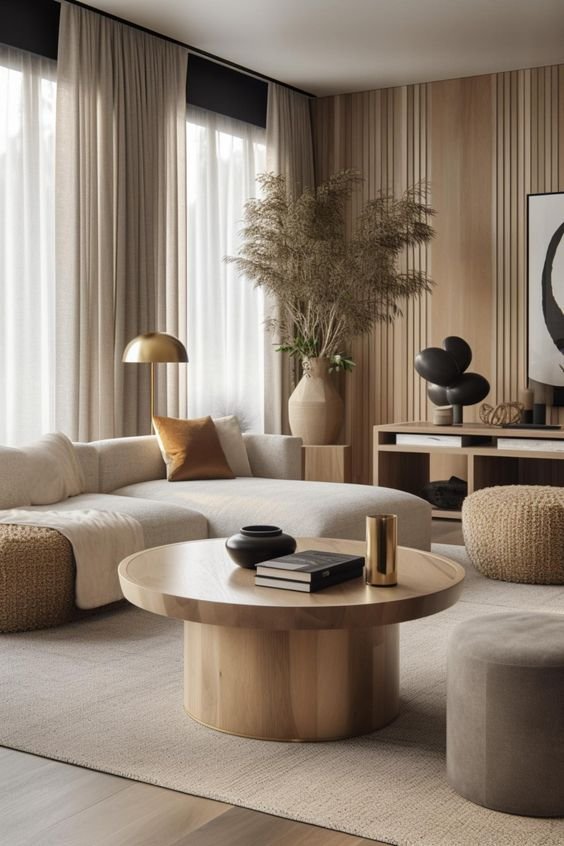How to decorate a neutral living room
Interiors expert and host of Selling Houses Australia Wendy Moore reveals how neutral spaces can be interesting, layered and sophisticated
A gorgeous neutral dining space with lots of layered timbers and textures. Image via Dezeen.com.
Wood, especially in natural finishes, contributes a tactile warmth that complements neutral shades beautifully. Image via homestratosphere.com,
So many people love decorating with neutrals; it’s so soothing and serene, and it definitely has longevity. There’s also a feeling of safety that goes along with choosing this palette, but it can easily slip in boring if you’re not careful. When I go neutral, there are a few tricks I employ to keep in interesting and timeless. Read on to discover how to make it work in your home, no matter what the space. While the focus of the ideas is a neutral living room, these really apply to any room, and you’ll find lots of neutral bedroom decor ideas here, too.
Trick 1: Mix warm and cool tones in a neutral living room
One of the secrets to creating a dynamic, visually engaging neutral colour scheme is mixing warm and cool tones. This strategy helps to avoid a flat, monotonous look by introducing subtle contrasts that make a space feel layered and well-rounded. For example, blending warm neutrals like beige, taupe, or camel with cooler tones such as soft greys, stone hues, or greyed-off whites can instantly bring balance and depth to a room. The warmth of beige or taupe adds a sense of cosiness, while cooler greys and whites bring a sense of calm and lightness. Together, they create a comfortable, inviting environment that feels modern and timeless.
For a little more texture, look to fabrics and accessories. Textured throws, woven rugs, or linen curtains can add a sense of depth, creating subtle contrasts without overpowering the neutral palette.
“Textured throws, woven rugs, or linen curtains can add a sense of depth, creating subtle contrasts without overpowering the neutral palette” ~ interiors expert Wendy Moore
Trick 2: Embrace the magic of monochrome
Decorating with neutral colours often creates a calming, timeless ambiance, but without a few well-placed accents, it can risk feeling flat or too uniform. A clever way to add depth and drama to a neutral room is to introduce monochrome elements—black and white accents that provide contrast and interest while maintaining the sophistication of the space.
Monochrome, especially in the form of black and white, is the perfect partner to a neutral palette because it enhances without overpowering. Black and white elements add definition to a room, helping the eye find focal points and bringing in structure. This subtle infusion of monochrome accents breaks up the softer shades without clashing, as black and white are classic, neutral tones themselves. Adding them to your decor can elevate the space with a bold, modern twist, even if the overall vibe remains understated.
Here’s three ways to bring in monochromes:
1. Artwork with impact: A large black-and-white photograph or abstract painting instantly draws the eye, adding visual interest without overwhelming the space. A gallery wall with black frames and white mats around family photos or minimalist prints can also make a striking statement.
2. Black and white accessories: Cushions and throws are an easy way to add monochrome patterns to a neutral sofa or chair. Choose pillows in graphic patterns that introduce movement and depth. You’re looking for a visual pop to enhance the overall palette.
3. Boldly patterned rugs: A monochrome rug with a subtle geometric pattern can instantly elevate a neutral room. Look for rugs that incorporate white, black, or grey patterns—think of herringbone, diamond, or Moroccan designs. These add character without making the space feel busy.
A layered neutral bedroom designed and built by Modern Nest. Image via Dan Ryan Studio.
Trick 3: Bring depth and warmth with layered textures
When decorating with neutrals, one of the most transformative tricks is layering textures. This approach brings tactile richness and visual depth to a room, creating a warm and inviting ambiance without relying on bold colours or patterns. It engages the senses, making the room feel as cosy as it looks.
In a neutral palette, interest comes from the depth and complexity that texture provides. It also adds warmth, essential in spaces that might otherwise feel too minimal or cold.
Lighting also plays an important role in showcasing texture. Soft, ambient lighting creates shadows and highlights that bring out the depth in fabrics and surfaces. A pendant light with a woven shade, for example, casts interesting shadows, while a floor lamp can bring warmth and highlight the details in a piece of art. Adding multiple light sources also enhances the tactile quality of the space.




